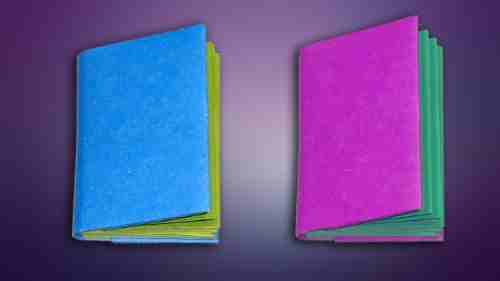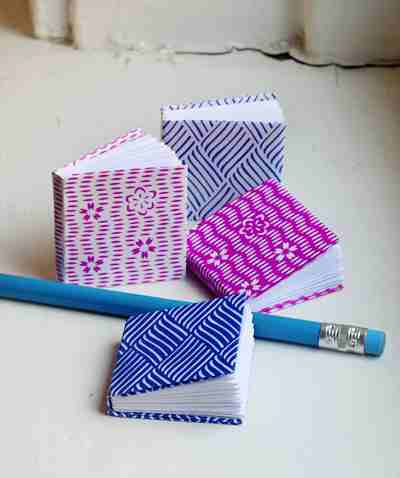It is possible to create a simple book of paper from a single sheet of rectangular or A4 paper. The book is a kirigami book is an excellent small DIY project you can make for your children,
Utilize origami folding techniques to cut the paper into 16 pieces. Then, cut the paper through specific folds until you create nine pages. Kirigami is an art style similar to origami in which you miss your writings.
You may need to add glue in the final step for a more secure finish.
There are numerous ways in which this tiny sheet of paper book can be utilized; among them are:
- Create a hand-made book instead of an ordinary greeting card and embellish it to mark a special event. It can be a unique, intricate enjoyable way to present someone with a unique gift you will keep and treasure.
- Utilize this little Kirigami book to create an upside-down book with animated animations in small increments.
- Create a miniature book to give your dolls to your children. There are several beautiful techniques you can use to create antique-looking small books.
- It is possible to use any size of paper, including one square. If you choose to use honest documents, it will mean that the book will come out in a square shape, too.
7 Tips for Crafting A Brilliant Book Title

Set your book goals
Make a list of your goals. Making this list will aid you in assessing whether your book name idea is your dream. Though this mainly applies to fiction, there are some steps which fiction authors can go through as well. If, say, your book belongs to the academic discipline, your goals will involve the education of your readers. Thus, your title should refrain from speaking humorously or using humour.
Target an Audience
Do you have an audience in your mind? If yes, it’s helpful to design a headline that identifies or explains your different audience’s specific characteristics. This same principle applies to targeting particular segments.
Brainstorm (Character or Setting)
Start getting your creativity flowing and get thinking about ideas! This method has no rules, and you can write as many book name ideas as you need. Feel free to write hundreds of book names since brainstorming is an ongoing but satisfying procedure.
It is possible to begin by introducing your protagonist and describing them using their unique and powerful name in the form of your book’s title. The author can make book names based on your story’s context, using words to define the period, date, or place.
Use a Book Title Generator Tool
Thought of book names can take time and effort. In times of stress caused by insufficiency of ideas, book title generators come to the rescue!
There are plenty of generators of book titles available online, the majority of that is accessible for download. According to your input, specific programs will mainly provide you with a non-fiction title for your book. Some will give you particular names for genres, like an esoteric story title generator. However, note that terms generated by these tools often do not fit or seem odd. Modifying will be required most of the time; therefore, take care when using title generators. Try our tool for generating titles in an attempt, and watch your book title ideas become a reality!
Use Noteworthy Phrases From Your Book
Do you have a memorable phrase in your book? Is your book have an enticing expression that can draw your viewers? The words or phrases that describe your concepts or contents will work effectively in novel titles.
Use Metaphors or Symbols Associated With Your Content
A lot of attention-grabbing titles employ poetic and literary terms to entice readers. It’s an opportunity to add some spice to a dull title and a task for authors to communicate their novel’s message in only a few words. The use of metaphors or images is initially exciting to readers.
Experiment With Words You Use
Be sure to have fun around with your words! The process involves brainstorming and changing the terms you are using to the place you place the words in the hope of creating a distinctive and engaging name.
Making a Small Book

- Make a page of paper into eights. Take your time folding it to ensure the accuracy of your folded pages will decide the overall quality of your book.
- Ensure that your folds are uniform and that you crease them all thoroughly. Consider sliding your fingernail or something solid, like the edge of an eraser, over the fold.
- Begin by folding the sheet to be comprehensive and thin (long edge folded inwards to create a longer edge).
- Fold the sheet in half from the short edge down to the sharper edge.
- Fold the sheet twice from the short edge to the sharp edge.
Fold the paper in half.
You may have eight sections. They will be part of the page of your book.
Fold the paper’s short edge towards the long edge.
You should fold the sheet in half in the opposite direction to your initial fold.
The paper should be cut.
The paper should be placed with the folded side towards you. Cut that vertical fold line in the centre of the form until it reaches the fold that runs horizontally.
Make sure you end up cutting on the horizontal edge. It is essential to stop at the flat seam. Are simply cutting a slit in the paper; you are taking care not to cut completely across.
Fold the paper in half.
The paper should be able to have the original eight-fold panels. However, there should be a gap between the four middle panels in the middle of the article.
Fold the sheet in half, extending the length toward the longest edge.
Repeat your initial fold. The folded part of your paper should be positioned along the centre of the edge you tucked.
Make the paper fold to form an booking form.
Turn on your paper to raise the edge cut in the air. After that, push the two boundaries towards each other. Cut the middle seams by moving them away from one another.
It is essential to reverse the direction of folds. Change to the opposite directions of the fold at one of the seams will be required.
The two ends should be pushed to one another until you have four “wings” moving outward from the centre. It’s like either an X or a cross.
Flatten your book.
Pick two parallel “wings” of the paper, pull them in towards one another, and then wrap the book’s page within them.
Protect the pages.
If you wish for your book to maintain its form, you may want to be able to bind your text by using strings or staples.
What Makes A Good Book Title
Unique and Evocative
If there’s a thing that stands out in the best-selling titles, they have distinctive as well as evocative titles. The captivating titles make readers want to choose the book by grabbing their attention through the utilization of words and images. However, unique titles help keep your book distinct from other books and therefore avoid popular names to help your publication stick out in the crowd.
Easy to Remember and Pronounce
The most famous names are typically short and straightforward.
It’s easy to grab the interest of your intended audience with lengthy titles. It’s also a well-known fact that many people have small memories. This makes longer titles a challenge to remember regardless of the number of powerful words you use.
Additionally, readers are better at recalling the words and phrases they hear, which are easily understood and understood. So, the next time you write a title for a story is sure to keep it in your mind to make your account brief and easy to understand yet powerful.
Informative But Not Too Much
This part is essential in fiction book titles. Although it is vital to inform your readers to know and comprehend your matter, defining your information is optional. Please use words or phrases that will catch your audience’s focus, and be sure not to overload them with information so they are enticed to read more.
Original
Using a unique name will make your book the distinction it deserves among the other books available. It won’t be easy to make a book make itself out if it has the same name as every other book. It’s essential to look up any possible book name before you decide on your ultimate story’s title. Do not even think about competing against a well-known book of the same name!